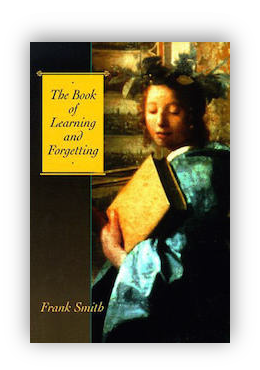About 4 years ago, Gary Stager gifted me a book. A wonderful book by Frank Smith: “The Book of Learning and Forgetting“. I read most of it but set it aside until I recently saw it on my night stand and decided to tackle it again. (Yes, ironically I forgot much of it)

I’m not going to do a review of the book but let’s just say it reinforces and confirms a wack sack of conversations and blog posts I’ve been part of over the past several years. The essence of the book suggests that we learn from the company we keep. All the drills, exercises and artificial learning constructs are based on the idea that learning is hard, based on how hard you try and easily measured. Smith contents that the classic view of learning, the way we learned for centuries, long before the advent of today’s education system, is based on the idea that we’re always learning, some of it good, some of it not but it’s essentially based on who we spend time with. Certainly the book expands more on this so I’d not suggest debating these ideas until you’ve read the book but it reaffirmed my own thinking that we’ve made teaching and learning way more complicated than it ought to be.
The idea of teacher as learner and modeling great learning is one critical notion that usually gets seen as a “nice, but not necessary” role in today’s data obsessed world. The idea of mentorship and relationships remains the key determination of learning and yet we have a whole sector of folks advocating for bigger factory models of skill and drill learning. I’m more convinced than ever that those middle schools who have adopted a mentoring model with teachers staying with students for 3-4 years is a return to the classic view of learning. The classic view also shows that inquiry is not simply a new pedagogy but one that acknowledges student interest and can potentially remove artificial barriers such as time from the learning. Again, not something earth shattering or new but places things in a historical perspective juxtaposed beside the recent view of learning that it needs to be fragmented and broken down into small bite chunks of learning.
 I’ve long been an advocate for social learning. Smith suggests all learning is social. The one room schoolhouse, while not a perfect learning environment, recognized the teacher having limited knowledge and time and relied on older, or more learned students helping those who needed help. The shift to a “mind your own business” style where arms covered work so no one could see it is the anti-thesis of classic and natural learning.
I’ve long been an advocate for social learning. Smith suggests all learning is social. The one room schoolhouse, while not a perfect learning environment, recognized the teacher having limited knowledge and time and relied on older, or more learned students helping those who needed help. The shift to a “mind your own business” style where arms covered work so no one could see it is the anti-thesis of classic and natural learning.
While many might argue that technology is making learning and education much more complicated than it used to be, I would argue that if viewed properly, it in fact makes things more simple. We now can help students find communities of learners based on what they are interested in learning, not simply a community of people the same age and who live in the same neighbourhood. That in itself is a powerful new affordance that gives me hope.
I understand many reading this may have questions and concerns but I’d invite you to read the book before you voice them. I believe we’ve made learning way more complicated than it should be. As teachers I maintain we have two very important roles to play that support the classic view of learning: model and connect. If we can see ourselves as mentors, mentors in how to learn and then connect our students to other learners who share their passions and interests we’ll have put ourselves in a wonderful position to truly make a difference for kids.